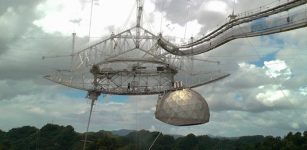Black Hole Only 3.3 Times Sun’s Mass Is Hiding In A Binary Star
Eddie Gonzales Jr. – MessageToEagle.com – New research proposes a new way to search for a class of black holes smaller than the smallest known black holes in the universe.
This new study also shows that astronomers might have been missing an entire class of black holes that they didn’t know existed.
 An artist’s rendering of the black hole astrophysicists identified in this study. The black hole (bottom left) is seen near a red giant star. The discovery shows there may be an entire class of black holes astronomers did not know existed. Image credit: Jason Shults(Ohio State
An artist’s rendering of the black hole astrophysicists identified in this study. The black hole (bottom left) is seen near a red giant star. The discovery shows there may be an entire class of black holes astronomers did not know existed. Image credit: Jason Shults(Ohio State
For years, the black holes scientists knew about were all in sizes between approximately five and 15 times the mass of the sun.
However, Todd Thompson, a professor of astronomy at the Ohio State University and lead author of the study, says that “there is another population out there that we have yet to really probe in the search for black holes.”
In 2017, LIGO (Laser Interferometer Gravitational-Wave Observatory) observed two black holes merging together in a galaxy about 1.8 million light-years away. One of those black holes was about 31 times the mass of the sun; the other about 25 times the mass of the sun.
But Thompson and other astrophysicists had long supposed that black holes might come in sizes outside the known range, and LIGO’s discovery proved that black holes could be larger. Thompson and other scientists used data from APOGEE (the Apache Point Observatory Galactic Evolution Experiment) which collected light spectra from around 100,000 stars across the Milky Way.
The spectra could show whether a star might be orbiting around another object, and the changes in spectra could show that a star was orbiting an unseen companion.
Thompson began combing through the data, looking for stars that showed that change, indicating that they might be orbiting a black hole. He narrowed data from the APOGEE to 200 stars that might be most interesting, and thus the astronomers found a giant red star that appeared to be orbiting something, but that something, based on their calculations, was likely much smaller than the known black holes in the Milky Way, but way bigger than most known neutron stars.
Further calculations contributed to finding a low-mass black hole, likely about 3.3 times the mass of the sun.
“What we’ve done here is come up with a new way to search for black holes, but we’ve also potentially identified one of the first of a new class of low-mass black holes that astronomers hadn’t previously known about,” Thompson said.
“The masses of things tell us about their formation and evolution, and they tell us about their nature.”
Written by Eddie Gonzales Jr. – MessageToEagle.com Staff










